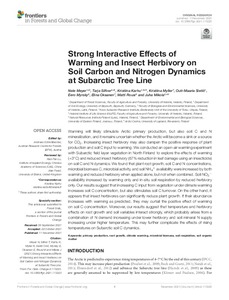Strong Interactive Effects of Warming and Insect Herbivory on Soil Carbon and Nitrogen Dynamics at Subarctic Tree Line
Myller Kristiina; Rousi Matti; Sietiö Outi-Maaria; Mikola Juha; Meyer Nele; Oksanen Elina; Karhu Kristiina; Myrsky Eero; Silfver Tarja
https://urn.fi/URN:NBN:fi-fe2022021519225
Tiivistelmä
Warming will likely stimulate Arctic primary production, but also soil C and N mineralization, and it remains uncertain whether the Arctic will become a sink or a source for CO2. Increasing insect herbivory may also dampen the positive response of plant production and soil C input to warming. We conducted an open-air warming experiment with Subarctic field layer vegetation in North Finland to explore the effects of warming (+3°C) and reduced insect herbivory (67% reduction in leaf damage using an insecticide) on soil C and N dynamics. We found that plant root growth, soil C and N concentrations, microbial biomass C, microbial activity, and soil NH4+ availability were increased by both warming and reduced herbivory when applied alone, but not when combined. Soil NO3– availability increased by warming only and in-situ soil respiration by reduced herbivory only. Our results suggest that increasing C input from vegetation under climate warming increases soil C concentration, but also stimulates soil C turnover. On the other hand, it appears that insect herbivores can significantly reduce plant growth. If their abundance increases with warming as predicted, they may curtail the positive effect of warming on soil C concentration. Moreover, our results suggest that temperature and herbivory effects on root growth and soil variables interact strongly, which probably arises from a combination of N demand increasing under lower herbivory and soil mineral N supply increasing under higher temperature. This may further complicate the effects of rising temperatures on Subarctic soil C dynamics.
Kokoelmat
- Rinnakkaistallenteet [19249]
